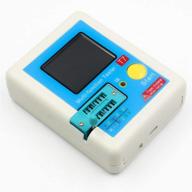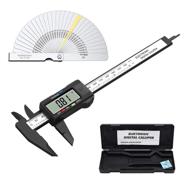
Review on Innova 3410 Light Circuit Tester by Rusty Calcara

Decent LED display for your money!
Just got the Innova 3410 test LED lamp and tried it out. It is a durable transparent plastic case made from two pieces pressed together. This leaves a seam and there is also some dotted graphics for the first 1.5 inches between the board and the corner piece of the handle. This graphic design makes it difficult to see the test light, which helps hide an LED light bulb a bit. The graphic design is actually indentations in the plastic designed to make the grip a little less slippery. to put fingers on it. I personally don't like it because it forces you to hold the test light in one position in your hand. What I like is that the plastic case runs more than halfway down the stainless steel shaft. Instead of using heat shrink tubing to prevent lateral contact with something if it accidentally falls, these guys simply lengthened the plastic body by half a stem. green LED. When you connect the light to the negative battery and touch 12V, the RED LED will light up. When you connect the light to the positive battery post and touch the ground, the GREEN LED will light up. The cable is flexible black rubber sleeve over 14 gauge white wire. The wire is traditionally soldered to the battery post. I see a couple of copper strands that they were careless with sticking out a bit where they enter the terminal. The clip is a traditional type of battery clip that I like because it is easy to squeeze and fits easily across the entire battery post on most batteries. The same type of clip you usually find on chargers and the regular size. The cable has a built in rubber strain relief and this part feels sturdier than the typical plastic strain relief spring end often used in test lamps. If I bend the cable 90 degrees and measure from the tip to the bent cable, it's about 8 5/8 inches long, which is the same length as the ATD-5513 I just bought when I bend the spring and adjust. also at the end. The bulbs are visible during the day, but the red bulb is the frontmost bulb (and the one used the most) and is difficult to see due to the clear plastic graphic design. Body. It is easier for left-handers to see the red light than for right-handers. Even if you can't see the bulb directly, you can see the red light it emits just fine in daylight, so it's not an impediment. .Innova, if you are reading this, remove the 45 degree angle on the handle, make it a straight 90 degree angle, and make the whole plastic body as clear as possible. Also move the red LED that illuminates the body. about where the green light is already. Side by side would be great. If the lightbulb were there, it would be easy to see regardless of the graphic design. Illuminate them below. For my fellow diagnosticians I measured the current with my Fluke 88 meter, the RED LED draws about 24mA. Strangely, the GREEN LED only draws 17 milliamps. It's a bit strange. Neither is enough to trip solenoids, so this LED test light should be computer safe enough. But it's useless if you like turning on the solenoids with a test lamp. That's enough current to probably start the base circuit in the transistor, so you could probably start something like LS1 ignition coils or foreign car igniters. (And it's probably safer to do so than to feed them the full 200 milliamps of an incandescent bulb.) I measured the inrush current (with my Fluke meter, not my oscilloscope) and it got the same 24 milliamps measured with the min/max function of my meter. Pros: High quality 6ft cable with beautifully shaped strain relief, green and red LEDs. Display of current and ground, extended handle over the shaft, well-soldered terminal, computer-safe low power consumption and price. Cons: Angled handle, red LED a little dimmed, no way to fix if it breaks, doesn't come with clear plastic tube over the pointed end. So far so good, and up to eleven deer is hard to beat. It's good to have an LED and an incandescent bulb in your box. You can use a lightbulb to turn on most low amp solenoids whenever you want. This LED won't do that, which is an advantage when testing sensitive PCM controls that you can burn if you don't know what you're doing.
- Satisfied so far
- Repair
New products
Comments (0)
Top products in 🛠️ Scanners & Testers

Xiaomi iHealth Meter Thermometer White

24 Review

ICQUANZX LCR-T7 Transistor Tester: Advanced TFT Diode Triode Capacitance LCR ESR Meter

14 Review

Detector Bosch GMS 120 Professional

28 Review

VIVREAL 4 In 1 Stud Finder Wall Scanner With LCD Display - Center Finding Beam Finder And Sound Warning For Wood, AC Wire, And Metal Studs (Black/Silver)

24 Review
Another interesting products

📏 CAMWAY 6 Inch Digital Caliper with LCD Display, Electronic Vernier Caliper, 150mm Stainless Steel Feeler Gauge, Plastic Digital Caliper Set for Zero Setting Inside/Outside Diameter, Depth, and Step Measurement Tool

3 Review

📏 Johnson Level and Tool 400EM-S 12-Inch Heavy Duty Metal Combination Square for Professionals, with Inch/Metric Measurements, Silver - 1 Square

8 Review

TV bracket Kromax DIX-18 black

52 Review

Kapro - 353 Professional Ledge-It Try & Mitre Square - For Leveling And Measuring - Features Stainless Steel Blade, Retractable Ledge, And Etched Ruler Markings - 12 Inch

23 Review

